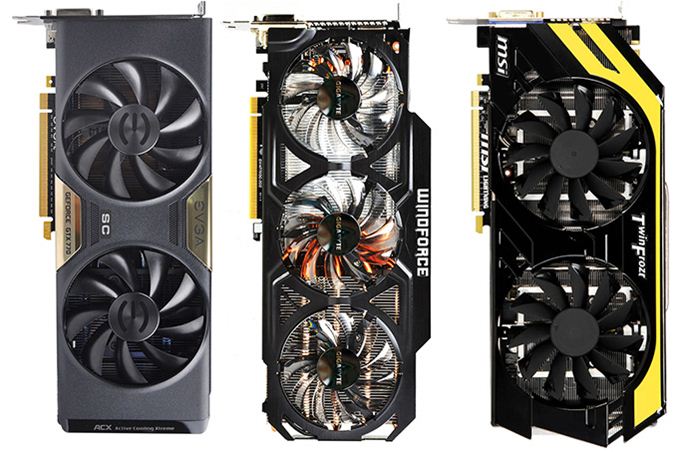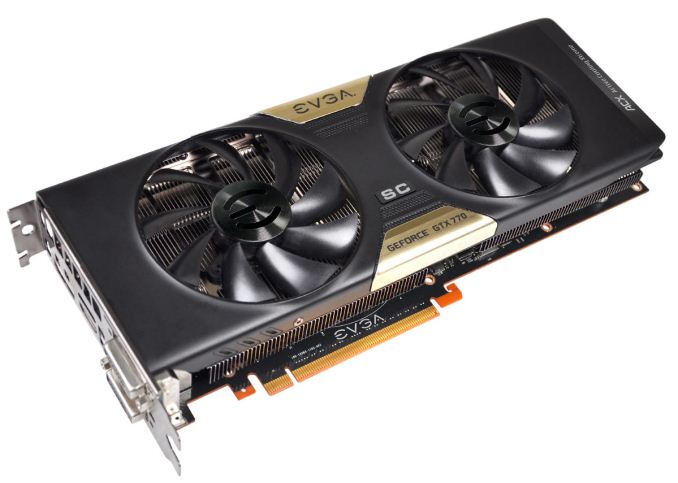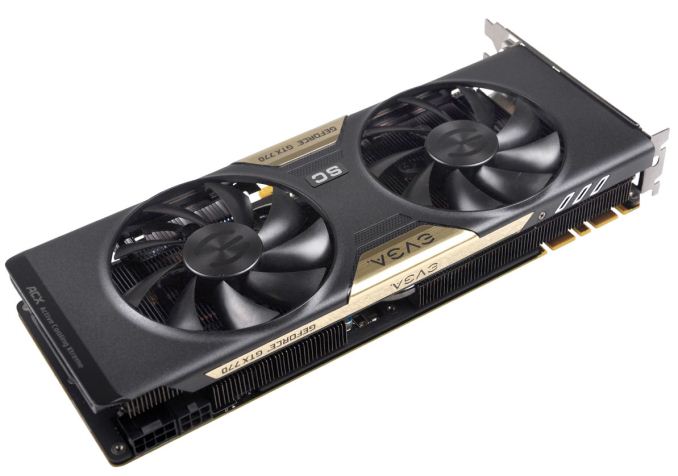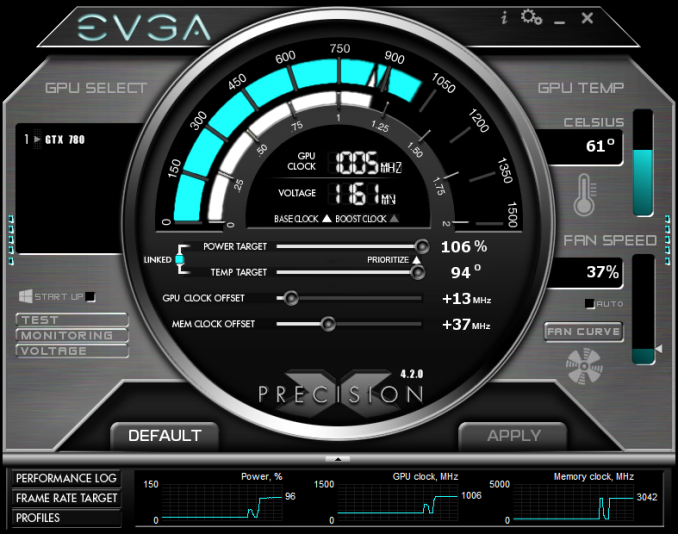The GeForce GTX 770 Roundup: EVGA, Gigabyte, and MSI Compared
by Ryan Smith on October 4, 2013 9:00 AM EST
Although it admittedly sounds derogatory at first, “small and unassuming” has become a good way to describe NVIDIA’s GK104 GPU. Unlike in past generations where NVIDIA’s high-end workhorse and flagship GPU were one in the same, for most of the lifespan of Kepler it has been GK104, not GK110, that has been the company’s high-end workhorse, being used in products spanning from $200 cards to $500 cards. At under 300mm2, GK104 products have proven capable of beating and/or tying AMD’s contemporary (and comparably more complex) products, which although a very good outcome for NVIDIA is certainly not the one we would have expected going into this generation.
At the same time however, GK104 being NVIDIA’s high-end workhorse has led to some unusual outcomes as NVIDIA attempts to pace themselves over the complete generation. Rather than scale down the more expensive GK110 GPU and its assorted products, NVIDIA has scaled up GK104 to keep their product lines fresh while continuing to hold off AMD, which is something they’ve never done before in this manner. This is especially evident in GeForce GTX 770, a very potent product that has seen NVIDIA release the first video card with 7GHz GDDR5, while in the process sacrificing some of their hard earned efficiency gains to reach their lofty performance goals. As a result of this GTX 770 is a product that is being pushed close to its limits right out of the box.
We bring this issue up because when it comes time to talk about custom vendor cards – as we’ll be doing today – it puts NVIDIA’s partners in an interesting and somewhat difficult position. Partners typically set their products apart by a combination of coolers, factory overclocking, and value added extras such as software and support. With NVIDIA pushing GTX 770 so hard partners aren’t getting access to the same lofty headroom that they enjoy in other products (e.g. GTX 780), which means GTX 770 ends up being a bit more constricting for the partners. To be sure there’s still room for them to maneuver on the clockspeed front, but when it comes to customizing GTX 770 a factory overclock isn’t going to make as much of an impact here.
With that in mind, today we’ll be looking at three such customized GTX 770 cards, from EVGA, Gigabyte, and MSI. All of these are semi-custom and fully custom cards pairing factory overclocks with custom coolers and custom software, so all three vendors are playing all three angles. How do these three partners set apart their products, especially in light of the constraints we just mentioned? Let’s find out.
| GeForce GTX 770 Specification Comparison | ||||||
| GeForce GTX 770 (Ref) | EVGA GTX 770 Superclocked ACX | Gigabyte GTX 770 OC Windforce 3X | MSI GTX 770 Lightning | |||
| Base Clock | 1046MHz | 1111MHz | 1137MHz | 1150MHz | ||
| Boost Clock | 1085MHz | 1163MHz | 1189MHz | 1202MHz | ||
| Memory Clock | 7GHz | 7GHz | 7GHz | 7GHz | ||
| VRAM | 2GB | 2GB | 2GB | 2GB | ||
| TDP | 230W | 230W | 230W | 260W | ||
| Width | Double Slot | Double Slot | Double Slot | Double Slot | ||
| Length | 10.5" | 10.5" | 11" | 11" | ||
| Warranty | N/A | 3 Year | 3 Year | 2 / 3 Year | ||
| Price | $399 | $399 | $399 | $434 | ||
EVGA GeForce GTX 770 Superclocked ACX
Our first card for this roundup is EVGA’s GTX 770 Superclocked ACX. Like its bigger brother who we reviewed last month, the 770SC ACX is a less than typical product for EVGA. The card itself is a semi-custom card, utilizing NVIDIA’s reference board but replacing NVIDIA’s Titan-esque metal blower for EVGA’s new ACX cooler. All of this is then wrapped up with a moderate factory overclock that sees EVGA ship the card at 1111MHz core, 65MHz (6%) over the GTX 770 reference clockspeeds.
Like the 780SC ACX, the 770SC ACX marks the first time we’ve seen EVGA’s new ACX cooler in this category of product. The ACX cooler is a notable departure from the norm for EVGA, who previously did not seriously involve themselves in the branded custom cooler market. With the ACX cooler EVGA is not only looking to tap into that market, alongside the larger market for open air coolers, but the company is looking to make a name for themselves based on build quality of their cooler, something EVGA’s competitors don’t always invest as heavily in and/or call as much attention to.
At its most basic level, the ACX cooler is a typical dual fan open air cooler, as we’ve seen countless times from other manufacturers. This basic design is very effective in moving large amounts of heat for relatively little noise, making the usual tradeoff of moving some of the cooling workload onto the system’s chassis (and its larger, slower fans) rather than doing the work entirely on its own. In EVGA’s case they’re using larger than typical fans for a dual fan cooler, with the ACX cooler’s fans coming in at 90mm diameter.
Meanwhile everyone has their own slight variations in design here, with EVGA focusing on running a full length heatsink to maximize their heatseak surface area. The heatsink itself is a two segment heatsink with 5 aluminum heatpipes running between the segments and the GPU. An aluminum baseplate runs the length of the card below the heatsink, providing both rigidity for the card and cooling for the VRAM and discrete components.
As for EVGA’s quality angle, the company is paying specific attention to the fans on their ACX cooler, using a fan blade design they say is optimized for strength and weight, while driving those fans with a double ball bearing motor. Much like the basic double fan design, ball bearings aren’t a major innovation in this space, but they are inconsistently used, often going unmentioned or interchanged with traditional sleeve bearings from one generation to the next. Mechanically speaking, compared to sleeve bearings, ball bearings typically have greater longevity and a bit less noise under heavy load, in exchange for a bit more noise at idle, making them a good tradeoff for a high-end card. From a practical point of view the longer lifespan of ball bearings will be the greatest gain out of this, while any noise tradeoffs are secondary as the fan itself will usually be the greater factor.
Cooling and factory overclock aside, the 770SC ACX is otherwise standard for a GTX 770 card. The card runs 10.5 inches long for both the PCB itself and EVGA’s ACX cooler. I/O is also standard with NVIDIA’s display I/O configuration of 2x DL-DVI, 1x HDMI, and 1x DisplayPort 1.2. Even the official TDP is the same at 230W, requiring the standard 6pin + 8pin external PCIe power connectors, which will be unlike some of the other cards in our roundup.
Rounding out the package is EVGA’s usual collection of software and hardware accessories, including a pair of PCIe power adapters and a DVI to VGA adapter. As far as EVGA’s software goes there’s little to be said that we haven’t said before: EVGA still shares the gold standard for software, with their fantastic Precision X overclocking utility and their OC Scanner X artifact scanning utility. Despite being based on the same RivaTuner core as MSI’s Afterburner, Precision X has diverged from Afterburner a bit over time, but as far as base overclocking and monitoring functions are concerned Precision X is among the best. And EVGA’s OC Scanner X software is second to none.
Meanwhile, as with all of EVGA’s North American cards, the 770SC ACX comes with EVGA’s standard 3 year transferable warranty, with individual 2 or 7 year extensions available for purchase upon registration, which will also unlock access to EVGA’s step-up upgrade program. Finally, the MSRP on the card is $409, only $10 above the MSRP for the standard GTX 770. However with a $10 mail in rebate active as of the time this was written, it brings the card down to $399, the MSRP of the stock GTX 770. As a result the card is something of a no-brainer within EVGA’s lineup, as it leaves no reason to purchase a slower card. The mild performance gains from the factory overclock won’t burn up the chart, but it makes the stock GTX 770 sufficiently redundant in performance.




















55 Comments
View All Comments
MarcHFR - Saturday, October 5, 2013 - link
Hi RyanTwo question
- 38 dBA is very high for idle. What's the measuring distance ? Background noise with computer off ? Noise of the computer with fanless graphic card ?
- What are the model of 7970 and 7970 GHz tested ?
Thans a lot !
Ryan Smith - Saturday, October 5, 2013 - link
1) It's fairly close; under a foot. The idea isn't so much to measure absolute noise as to compare and rank cards.2) Reference 7970. HIS IceQ X2 7970 GHz Edition.
MarcHFR - Sunday, October 6, 2013 - link
Thanks, so less than one foot from the closed Thermaltake Speedo, that's it ?And what about background and computer (without active graphic card) noise ? What is the sound-level meter used ? Thanks
PC Perv - Saturday, October 5, 2013 - link
It is interesting to see how far the custom cooling solutions (and custom PCBs) have come on video cards. I know it is nothing new and obviously marketing-driven, but nevertheless gives consumers more choices and better experiences.Thank you for thorough review, Ryan.
PC Perv - Saturday, October 5, 2013 - link
Even betweein the same OEM's cooler's, I see how they "evolved." For instance, Gigabyte's WindForce had quite a few shortcomings at first - no heatsinks on memory/VRMs, fan rattling and getting worse over time, etc. It's great to see that they are learning and improving.Slomo4shO - Sunday, October 6, 2013 - link
I would love to see an expansion to the OC section of these reviews and having OC figures for the comparison cards as well (760, 780, 7970, and 7970GE). Can you or whoever is writing up the review the upcoming R9 280X also include the OC benchmarks of the 770s in the overclock section of that review?marraco - Sunday, October 6, 2013 - link
Something that would be very useful and valuable for differentiation purposes would be a card easy to clean. All of my cards get his radiators completely occluded with dust from time to time, and cleaning them is incredibely annoying.I wish it could be as easy as trowing the radiator and fans to the dishwasher. But it never is as simple. I don't dare to wet my fans, because they are not detachable from the engines. And removing the radiator mean having silicone paste to reinstall them. Frequently I don't ever have silicone paste. I need to buy more, and that's a delay, and an impediment to clean the cards at convenient times.
Same goes for CPU and power refrigeration systems.
ShieTar - Monday, October 7, 2013 - link
Is there any chance to add an SLI of 2x GTX 760 to this round of benchmarks? This option costs less than a GTX780, but has the potential of out-performing a Titan. Therefore it would be very interesting to see how it performs in reality.The Warden - Sunday, November 3, 2013 - link
Ryan, can you tell me if this GTX 770 would be a good choice to replace my very old ATI Radeon HD 2600 XT for the specific purpose of improving my Final Cut Pro editing processes? I just don't know if the graphics cards play that big a roll in the editing displays and playback for Final Cut, and if I am just fine with what I have.Chloiber - Thursday, November 21, 2013 - link
I'm really disappointed by the EVGA card. I currently own a 770 SC ACX. It's loud in idle (fan won't go below 1400rpm), it's pretty loud under load. Why do I even buy a custom card? For the 50MHz higher boost?They clearly forgot what a custom card is all about. You can get a silent BIOS from the support which reduces the idle fan speed to 1100rpm. Still way too loud for my taste.
Same goes for the ASUS DC2OC by the way. It's quieter in idle, but fans won't go below 1100rpm.